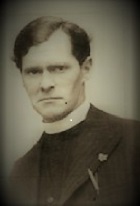(Please note that “context” is not an assessed element of this component of the WJEC in English Literature.)
Ronald Stuart Thomas was born in Cardiff in March 1913. The family were in Liverpool for much of World War I, but in 1918 they moved to Holyhead, Anglesey, where the young Thomas was primarily brought up. At university in Bangor, Thomas studied classics. Then he went to St Michael’s College, Llandaff, in Cardiff, to be trained as an Anglican priest. During his first curacy, in Chirk on the Wales-England border (1936–40), he met the painter Mildred Elsi Eldridge (‘Elsi’; 1909-1991) and they were married in 1940. Elsi’s artistic reputation became obscured over the course of her married life and she is now mainly remembered for the miniatures of birds and plants she produced from the late 1950s onwards. However, she was an artist of considerable achievement, and the centrepiece of her work is the large mural ‘The Dance of Life’, now at Glyndŵr University.
Thomas was vicar in Manafon (Montgomeryshire, 1942–54), Eglwys-Fach (near Aberystwyth, 1954–67), and finally Aberdaron (on the Llŷn Peninsula, from 1967). He retired from Aberdaron in 1978, but stayed in the area, living in the early-seventeenth-century cottage Sarn Rhiw (or Sarn Y Plas), which was austere and very cold. Elsi died in 1991, and the 1992 volume Mass for Hard Times was dedicated to her. The critic M. Wynn Thomas notes that in the aftermath of his wife’s death R. S. Thomas ‘teetered, at times, on the very brink of delusion and breakdown’ [1].
Late in his life, Thomas was nominated for the Nobel Prize in Literature but did not win. He died in September 2000.
(A longer biography is available in the Library of Wales anthology: Poetry 1900-2000 ed. Meic Stephens, pp.135-137)
[1] M. Wynn Thomas, ‘The Poet of Sarn Rhiw’, in John Barnie, ed., Encounters with R. S.: R. S. Thomas at 100 (Swansea: The Hmm Foundation, 2013), pp. 28-35: p. 33.






R. S. Thomas’s early poetry was particularly known for its engagement with the hill-farming communities of mid-Wales where he lived. ‘A Marriage’, however, is from his later period (which dates broadly from the time he moved to Aberdaron in 1967) and shows his increasing engagement with very basic human questions: here, specifically, time, love and death. Indeed, the critic M. Wynn Thomas groups ‘A Marriage’ with R. S. Thomas’s poems that respond to his family and that ‘contribute, and indeed participate in, [his …] exploration of the mystery of being’.[1]
However, the poem cannot be reduced to just these ideas: they cannot be divorced from its specific way of engaging with them and presenting them. Thus, for example, these ideas are bound up with the delicate elegance of the poem’s form on the page (note how death is itself almost delicate in the final lines), and with the way that the poem consistently binds together human and avian life. In this latter sense, ‘A Marriage’ is not just simply an elegy for Elsi; instead, it is a poem that also mourns the shared experiences of the poet and his wife – their shared interest in birds. In this sense, it is an elegy for shared life, for a relationship.
The poem’s language is generally simple, or “conversational”, giving the impression – on an initial level – of a straightforward, heart-felt statement by the poem’s speaker. However, note that not all the poem’s words can be classed in this way: ‘shower’ is complicated in the sense of being somewhat ambiguous (as discussed above); ‘servitude’ is not conversational in register; ‘bill’ is a rather less common word for ‘beak’; and the word ‘grace’ is well worth pausing over, given that R. S. Thomas was a vicar – and ‘grace’ has a specific meaning within Christian thinking (the notion of God’s freely-given generosity to humanity, particularly expressed through salvation from sin and death). Thus, the phrase ‘a bird’s grace’ may well refer primarily to ideas of delicate elegance; but it also has an undertow of meaning that points to a sort of salvation – a higher spiritual state that the phrase associates with birds (and, by extension, with the poem’s bird-like ‘she’). The poem, in short, is not without sophistication on the level of language – alerting readers to the point that it is very much a literary construction, not merely an outpouring of feeling.
The critic M. Wynn Thomas points out that ‘A Marriage’ is just one of a group of poems about his wife that R. S. Thomas wrote over the course of his poetic career.[2] So the borders of this poem do not stop at the edges of the page; instead, they are in ‘intertextual’ dialogue with other poems that Thomas wrote over many years.
[1] M. Wynn Thomas, R. S. Thomas: Serial Obsessive (Cardiff: University of Wales Press, 2013), pp. 144-5. For a collection of poems by Thomas to his first wife, see R. S. Thomas, Poems to Elsi, ed. by Damian Walford Davies (Bridgend: Seren, 2013).
[2] M. Wynn Thomas, R. S. Thomas: Serial Obsessive, pp. 143-4.